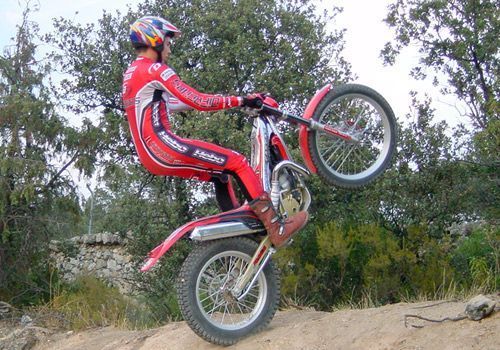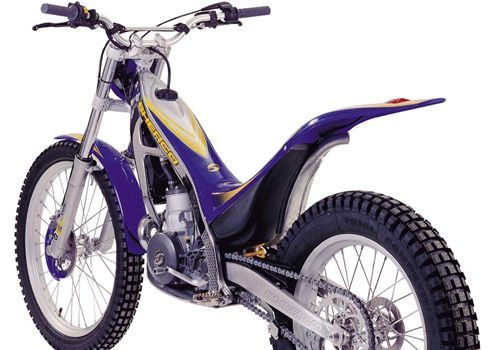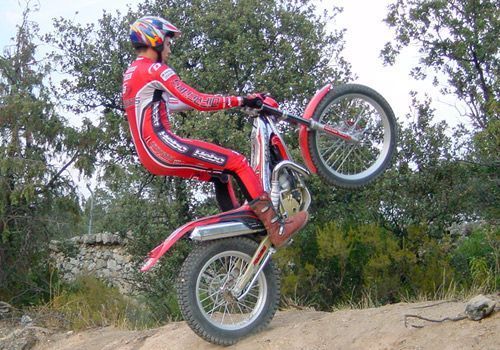
In Gas Gas, with the arrival of a new engine, put an end to a stage in which the 250 version actually had 238cc, and proceeded to the assembly of a cylinder with 249cc, thus reviving the response of the engine. For its part, Sherco has been equipped with a 249cc engine designed by Paxau since 1999, which is still in use today, although properly evolved. In 2003, as we can see at a glance, both mounts share with the rest of the range both the structure of the chassis and the components. As a result, they also benefit from all the improvements introduced for the 2003 season, which we are now refreshing.
Power
On the one hand, the Gas Gas “Pro”, which has undergone a thorough revision to face its second year of life, in order to achieve a more robust and reliable set than its predecessor. To do this, the 2002 chassis has been used, to which the geometries have been varied, looking for more poise in the front axle, thus obtaining more grip and precision when making turns. In themechanical field, we find important modifications in the clutch, a weak point of last year, which has been thoroughly reviewed, corrected by the assembly of a new crankcase, which this time has a greater oil capacity and new clutch discs. On the other hand, the 249 – like the 280 – has been fitted with a new cylinder head and exhaust system, thus smoothing out the engine’s response.
What does differ from its big brother is in the carburetion section, since it continues to bet on the traditional and effective Dell’orto PHBL, instead of incorporating the new VHTS version. As far as the cycle part is concerned, we contemplate few variations, mainly shorter fork bars have been mounted, on the other hand, the set incorporates a new air filter box, thus correcting the leakage problems of the previous model.
Accurate
The Sherco, on the other hand, is satisfied with slight modifications that fundamentally affect the part of the cycle, aimed at adapting to the new regulations. Consequently, starting from the chassis of the 2002 model, its geometries have been varied – as well as the Gas Gas – in search of greater agility. The suspensions of both axles have been reviewed, fundamentally the work has focused on the search for new settings, which would allow to gain traction and progressivity to the whole. In the mechanical section we have few novelties, the most substantial is the incorporation of different gear developments, successfully applied in competition.

Balanced
As a result of their development in the world of competition, the 280 versions of Gas Gas and the 2.9 Sherco have evolved a lot, not only in the technical aspect, but today the feeling of weight and handling they offer, are very similar to that of the 250. Based on these premises, it is clear that the quarter-liter has lost a lot of ground, so it would not be unreasonable to say that the two bikes tested this month share a factory with their biggest rival. To win this battle, the 250 seduces in a different way, boasts docility and transmits to the rider a permanent sense of control. In the recent comparison 2003 (nº294 Moto Verde) we had the opportunity to offer you an extensive analysis of all its competitors, now we complete the report with the arrival of the two and a half versions manufactured by Gas Gas and Sherco.
At first glance, we will only distinguish them from their older sisters by a small sticker, the TXT 249 that incorporates the Gas Gas on its swingarm, and by the 2.5 badge on the Sherco fender. The lower compression of these mounts makes it easier for us to start, optimal in both versions, although the cold start of the Sherco is somewhat conflicting.
Once we find ourselves riding on them, we realize that both the driving position and the feel of the controls remain the same as the rest of their sisters. So far everything is the same, the first differences begin to emerge when we face any obstacle, the most notorious and relevant is the response of the engine. The two engines are brilliant, both have a feel that is very reminiscent of their congenitals, although the tested versions transmit sweeter reactions at low revs, helping the pilot a lot, especially in twisty areas, where the feel of the gas is essential. The Gas Gas has a more explosive engine, not as forceful as that of a 280, but it climbs very fast in revs and has a magnificent final stretch.
Thus, you get a very fun mechanic as well as effective. The problems of emb
Rague have finally been corrected, this one shows a good feel, too bad that the gearbox is still somewhat imprecise and has too much travel. The Sherco, on the other hand, equips a mechanics with a very linear response, it is more precise in its first stroke of throttle than its rival, an aspect that together with the effectiveness of the adjustments made in the rear shock absorber, favor traction on slippery surfaces.
Both because of the response of the mechanics, and because of the gear ratio they equip, these mounts defend themselves better at short speeds , encouraging the use of the former, especially in the case of the Gas Gas, since it has longer gears than its rival.
Let’s move on to the part of the cycle, another of the points where the two frames transmit very different sensations. The front end of the Sherco is very playful but at the same time it is quite imprese, the Paioli fork mounts excessively soft settings, and does not have the possibility of being adjusted externally, something that happens in the rest of the models on the market. The rear shock absorber offers impeccable, progressive and efficient handling. On the Gas Gas the opposite happens, while the fork has an excellent feel, the rear shock settings do not convince us, they are somewhat harsh. Continuing with the brake section, outstanding for both, despite the fact that the Sherco does not mount perforated discs, the efficiency in rain and mud is extraordinary. The Gas Gas follows the same line as its rival, the AJP components perfectly combine power and progressiveness.
Looking at the weight figures and measurements, the Gas Gas is victorious, since this one in addition to being 5mm shorter, is 2.6 Kg ahead of the Sherco, standing with a final weight of 72.3 Kg in running order.
What’s new in Gas Gas TXT Pro 2003
Engine
* Different stock, for a smoother response.
* Crankcase with more oil capacity.
* Reinforced clutch cover, with new oil passage ducts, which improve cooling.
* Different clutch discs. Increased oil flow throughout the system.
* Modified electric fan.
* Ignition cover with different anchorage.
* Better oiled crankshaft bearings, taking the oil from the clutch and gearbox.
* Different intermediate and silent exhaust.
Cycle part
* Chassis with different geometry, in search of greater agility.
* Shorter fork bars.
* Larger fuel tank, with 3 liters capacity.
* Distinct crown guard.
* Tighter filter box.
*Decoration.
What’s New Sherco 2.5 2003
Engine
* Different gear ratio.
* More robust and effective clutch hub.
Cycle part
* Different chassis geometry, for the sake of better handling and agility.
* Rear suspension with a different progressivity curve.
* Paioli fork with modified set-up.
* Airtighter air filter box.
* Updated décor. Finished in matt polished aluminium.









